
View of the village of Herrnsheim with the Catholic Church in the background.
Posted 1940.
|
| |

|
|
| Postcard collection of Maggie Land Blanck, 2013
View of the village of Herrnsheim with the Catholic Church in the background. Posted 1940. | |
|
| |

|
|
| Postcard collection of Maggie Land Blanck, 2013
Main street with Catholic Church in the background. Posted 1940. | |
|
| |
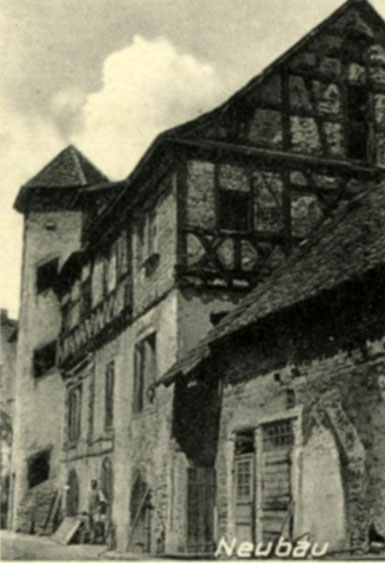
|
|
| Postcard collection of Maggie Land Blanck, 2013
Neubau [new construction]. This must be a "joke". Posted 1940. | |
|
| |
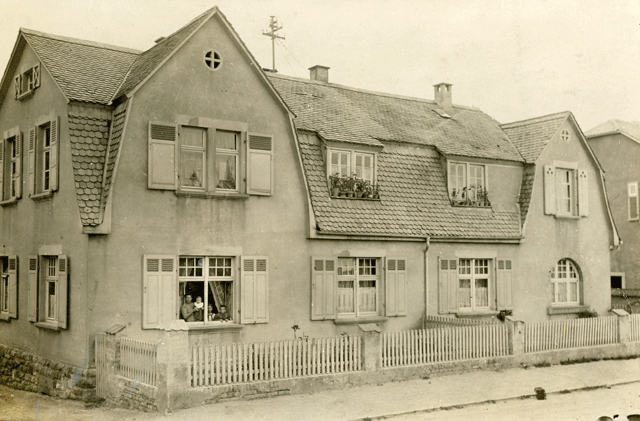
| |
|
Postcard collection of Maggie Land Blanck
Written on back in Pencil "1917 - Joachim's Haus in Herrnsheim bei Wormes | |
|
| |
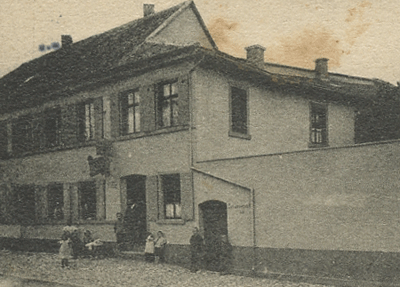
| Spezereihandlung u. Restauration von Adam Franz Mitzel, Herrnsheim |
| Postcard collection of Maggie Blanck, 2007 | |
|
| |
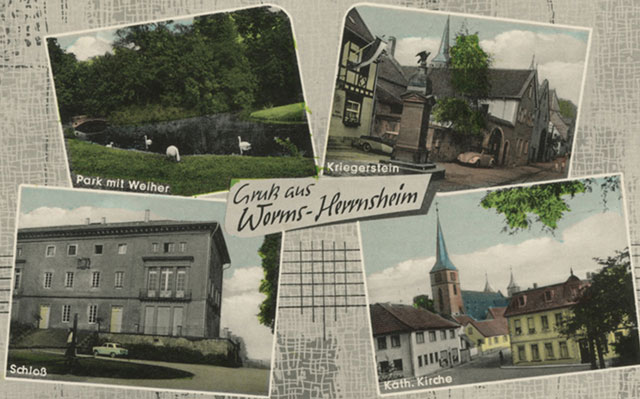
|
|
| Postcard collection of Maggie Land Blanck, 2013
Printed on front "Grus aus Worms-Herrnsheim - park mit weiher, Kriegerstein, Schloss, Kath. Kirche" [Greetings from Worms-herrnsheim - park with pond, War Memorial, Castle, Catholic Church] | |
|
| |
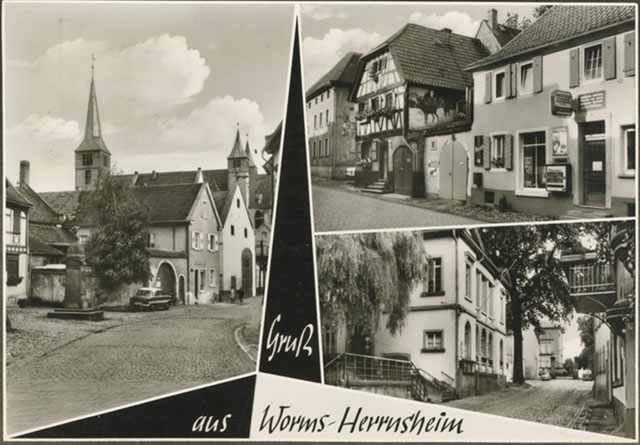
|
|
| Postcard collection of Maggie Land Blanck, 2013
Printed on front "Grus aus Worms-Herrnsheim"On the left is the main street with the war memorial, several houses and the Catholic Church in the background. I do not know the location of the upper right image. The lower right images has the rathaus [town hall] on the left with the Schloss in the background.
| |
|
| |
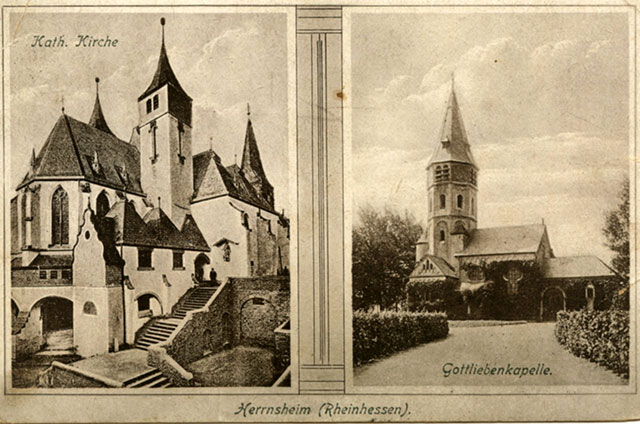
|
|
| Postcard collection of Maggie Land Blanck, 2013
Castle on top left and Gottliebenkapelle on bottom right Gasthauf zur Krone in the top middle. Printed on back Gasthaus zur Krone. Bes. Leonh Adolf Herrnsheim bie Worms a Rh. | |
|
| |
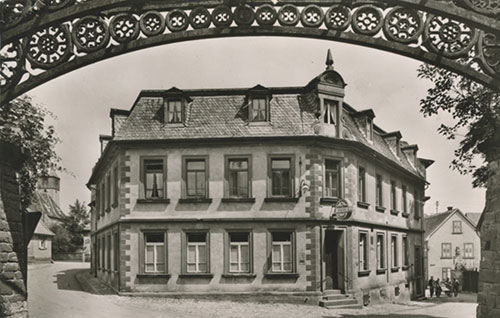
|
|
| Postcard collection of Maggie Land Blanck, 2013
Parkrestaurant "Zum Grünen Baum" Worms-Herrnsheim
| |
|
| |
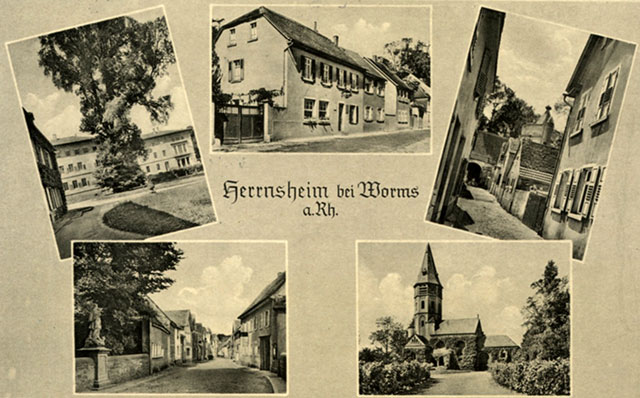
|
|
| Postcard collection of Maggie Land Blanck, 2013
Catholic Church (on the left) and the Gottliebenkapelle
| |
|
| |

|
|
| Postcard collection of Maggie Land Blanck, 2011
Printed on back "Gasthaus "Zur Krone", Heribert Pattenhoholz, Worms-Herrnsheim, Schone Fremdenzimmer mit fl. wasser u. Zentralhelizung, Grosser Saal, Mod. KegelbahnPosted 1967 | |
|
| |
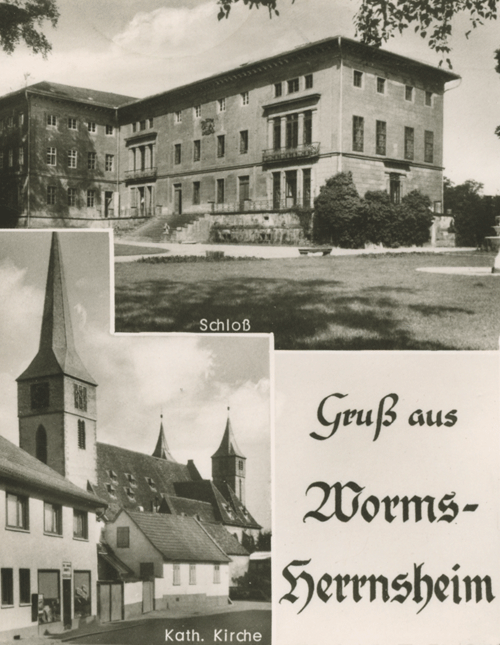
|
|
| Postcard collection of Maggie Land Blanck, 2011 The castle and the Catholic Church Posted 1967 | |
|
| |
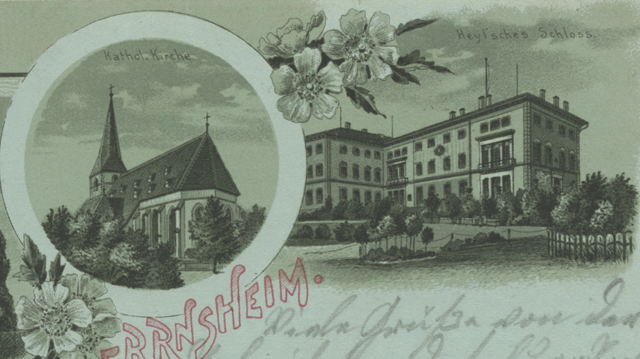
|
|
| Postcard collection of Maggie Land Blanck, 2011 The castle and the Catholic Church
| |
|
| |
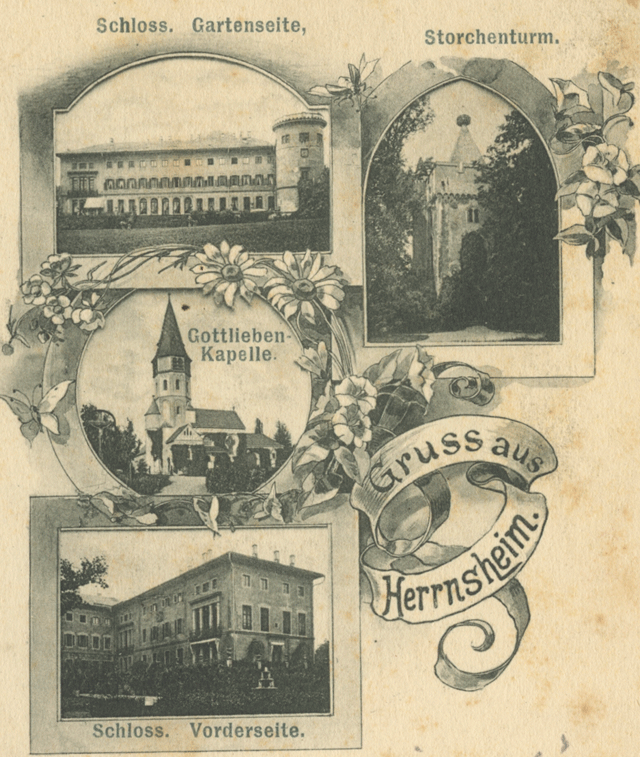
|
|
| Postcard collection of Maggie Land Blanck, 2011
| |
|
| |

| Ansicht vom Bahnhof, Herrnsheim |
| Postcard collection of Maggie Blanck, 2007 | |
|
| |
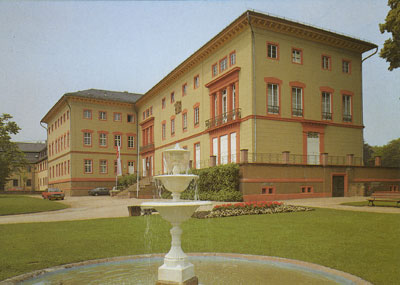
| Herrnsheim, the Gentleman's House "Empire style mansion of the Barons of Dalberg" |
| Cathedral Museums City, Worms Fritz Reuter Concise City Guide | |
|
| |
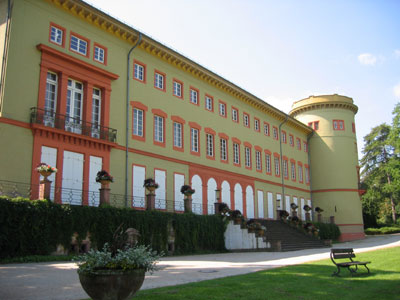
| Herrnsheim, the Gentleman's House Park side |
| Photo Maggie Blanck, 2007 | |
|
| |
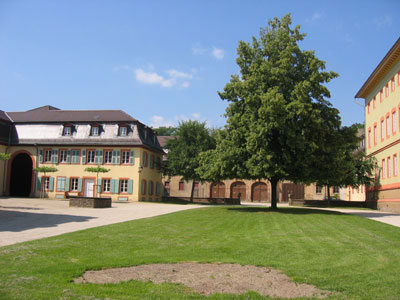
| Herrnsheim, the Gentleman's House Out buildings dating to the 18th century. |
| Photo Maggie Blanck, 2007 | |
|
| |
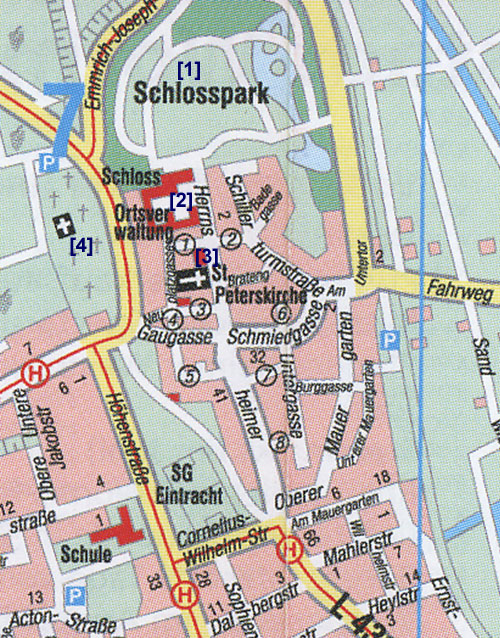
| The map shows the Schlosspark [1], the Schloss
(Gentleman's House) [2], the church of St Peter [3]
and the cemetery [4].
The village existed, in essence, as support of the "Gentleman's House". The church of St Peter is situated just outside the gates of the Schloss as is the Rathof (Town Hall). The rest of the village extends south of Schloss. Much of the surrounding are is planted in vineyards and the town is known for it's wineries. |
|
| |
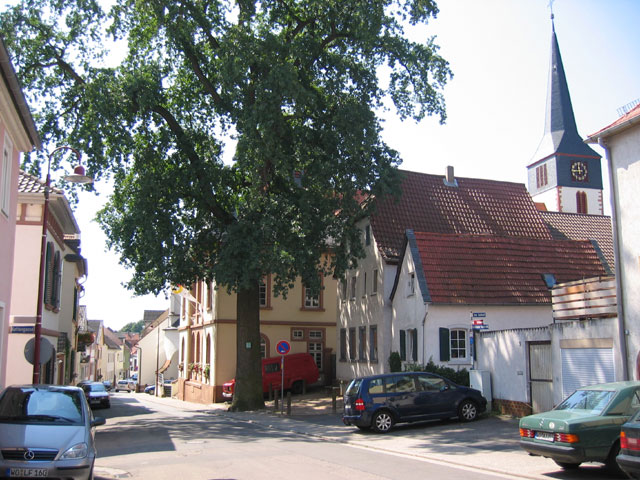
|
|
|
Photo Maggie Blanck, 2007 Looking from the gate of the Schloss - a view of the Rathof (the yellow building on the right) and the spire of the church. | |
|
| |
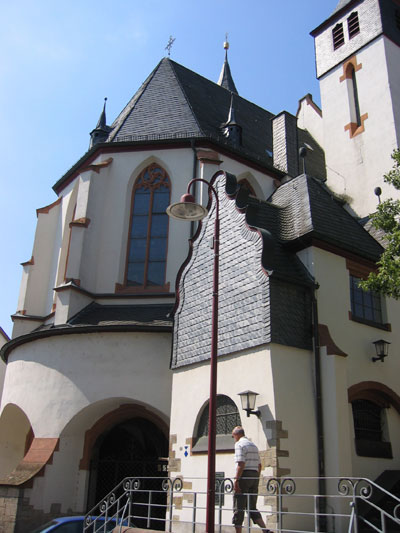
| St Peter's Roman Catholic Church as seen from the main street. Accoding to a marker on the front of the church, the original church dates to the end of the 11th Century. Alterations were made in 1478, 1878 and 1904. |
| Photo Maggie Blanck, 2007 A hand-book for travellers on the continent: being a guide through Holland ...1847 By John Murray (Firm) dates the church in Herrnsheim to the 14th century and noted that it contained several von Dalberg monuments.
| |
|
| |
|
From 1785 to 1797 the parish priest in Herrnsheim was
Joseph Sambuga. Joseph Anton Sambuga was born near Heidlelberg, Germany in 1752, the son of Italian parents. He began his studies in Germany but moved to Italy where he was ordained at Como in 1774. He returned to Germany where he became the parish priest in Herrnsheim in 1785. He remained there until 1797 when he was called to the Court at Mannheim to become the religious instructor to Prince Louis who later became King Louis I of Bavaria. See New Advent, Joseph Anton Sambuga | |
|
| |
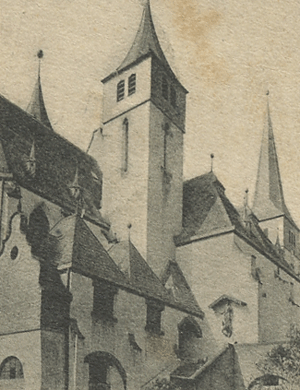
| St Peter's RC Church, Herrnsheim |
| Postcard collection of Maggie Blanck, 2007 | |
|
| |
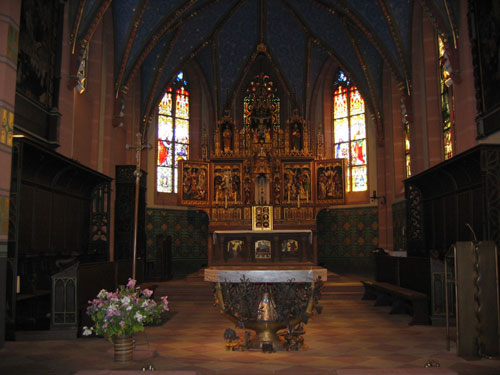
| Interior St Peter's RC Church, Herrnsheim |
| Photo Maggie Blanck, 2007 | |
|
| |
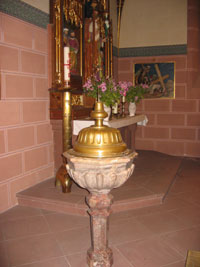
| Baptismal font St Peter's RC Church, Herrnsheim |
| Photo Maggie Blanck, 2007 | |
|
| |
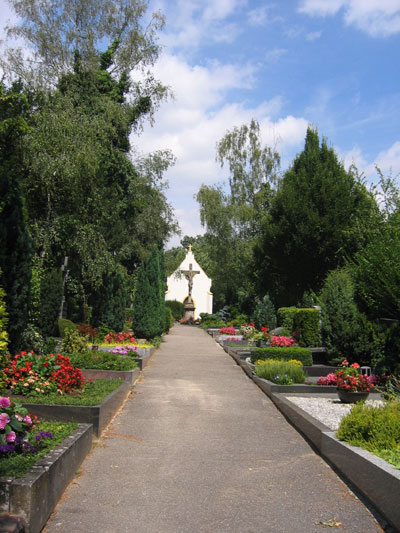
| Cemetery, Herrnsheim Unfortunately for the genealogist many Germany cemeteries do not contain an abundance of old grave markers. While some gravesites are owned by a single family many are leased for a 20 to 25 year period. Only graves with historical importance are sometimes maintained for a longer period. Even those graves owned by a family are frequently reused by later generations. Only 20th century military graves are not reused. As this image of the Herrnsheim Cemetery indicates, Germany cemeteries are generally well maintained and often have a parklike atmosphere. |
| Photo Maggie Blanck, 2007 | |
|
| |

| Herrnsheim
|
| Photo Maggie Blanck, 2007 | |
|
| |
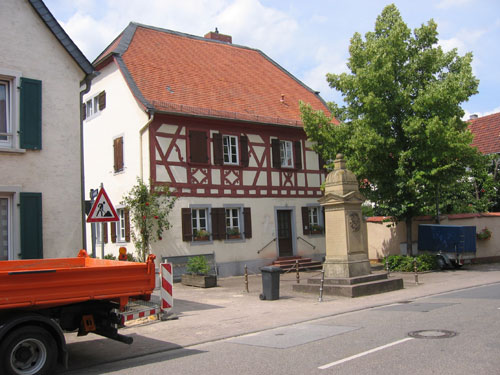
| The monument is to soldiers from Herrnsheim who fell in Franco-Prussian War
(19 July 1870-10 May 1871)
|
| Photo Maggie Blanck, 2007 | |
|
| |
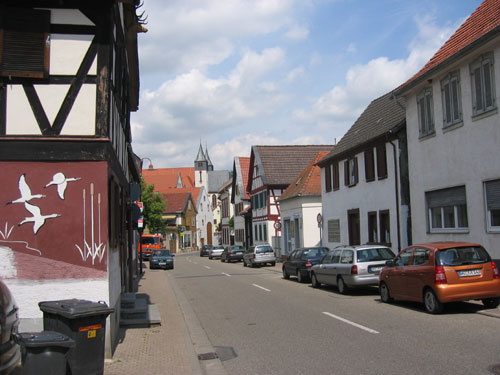
| The main street of Herrnsheim looking toward the church.
|
| Photo Maggie Blanck, 2007 | |
|
| |
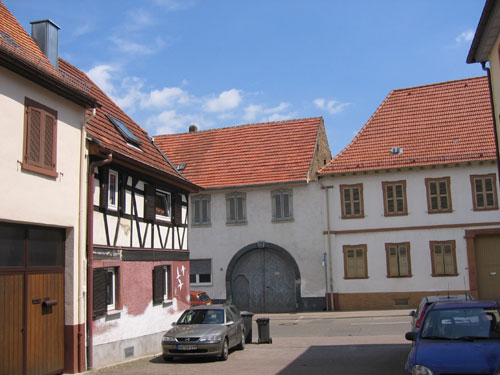
| |
| Photo Maggie Blanck, 2007 | |
|
| |

| |
| Photo Maggie Blanck, 2007 | |
|
| |
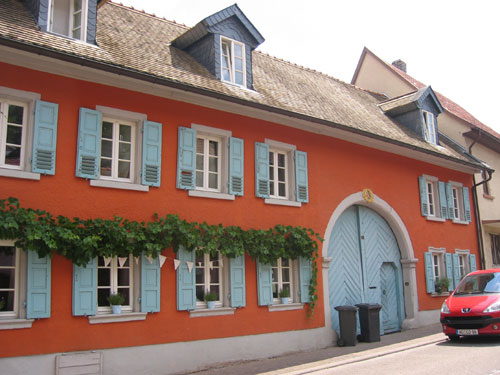
| There are many stately old farm houses on the main street of Herrnsheim. A
medallion over the blue door is dated 1736.
|
| Photo Maggie Blanck, 2007 | |
|
| |
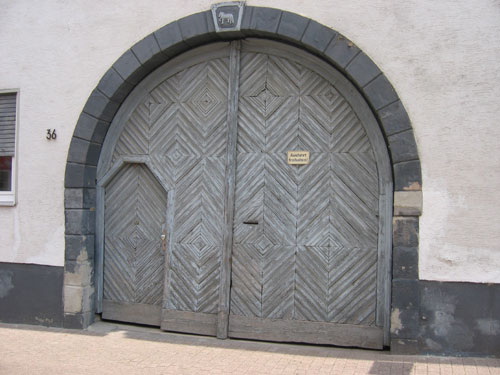
| Herrnsheim
|
| Photo Maggie Blanck, 2007 | |
|
| |
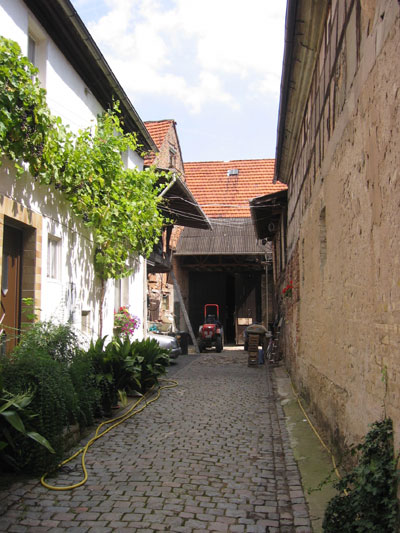
| Behind many of the large doors are old farm buildings or wineries.
Herrnsheim has been a wine growing area since the middle ages.
|
| Photo Maggie Blanck, 2007 | |
|
| |
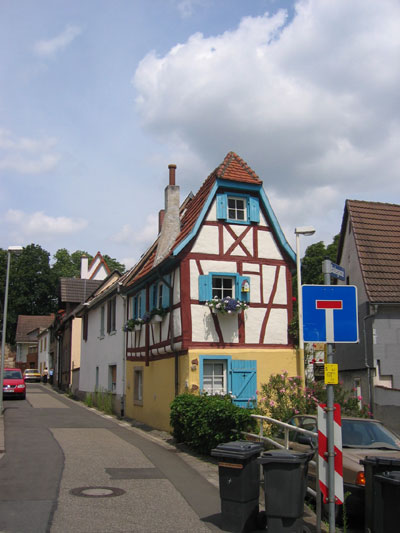
| Herrnsheim
|
| Photo Maggie Blanck, 2007 | |
|
| |
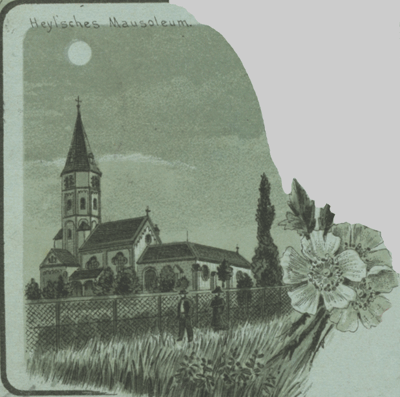
|
"Heylisches Mausoleum" |
| Postcard collection of Maggie Land Blanck, 2011
Gottleiben Chapel Gabriel von Seidl (1848-1913), a prominent German architect, designed the Protestant St. Gottleiben (God of Love or God loves) Chapel in Herrnshiem in 1891. This chapel contains a cloister and is the mausoleum of the Baron von Heyl zu Herrnsheim.
| |
|
| |
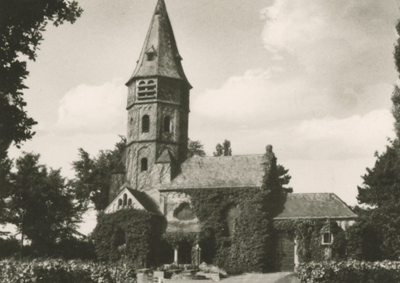
|
Gottlieben Kapelle |
| Postcard collection of Maggie Land Blanck, 2011
| |
|
| ||
| In December 2010 Mother Catherine of the Carmel of St Joseph Ontario, Canada
contacted me about this crucifix which was donated to them from Dr. Werner K Adrian (1930-2008) whose
family received it in 1779 from the Herzog (Duke) Dalberg of the Castle of Herrnsheim. The crucifix measures 39 inches by 16 inches. Its exact date of origin is not known but Dr. Adrian put it in the early Baroque around 1600 to 1650, but added "An antiquarian thought that the cross is presumably dating back to the early 1800, but was not sure." Dr Adrian wrote: "It was reported that at New Years Eve 1778 von Dalberg lost the whole estate in gambling. One of my ancestors served as custodian in the castle and was a confidant to the Herzog. Before the estate was transferred, von Dalberg asked him to take something form the Schloss which he would like to have as a memory. So he took the crucifix among other things that have been lost in the meantime." |

|
|
|
Herrnsheim as discribed in 1877, five years after Peter Goehle emigrated to America Kunstdenkmäler im Grossherzogthum Hessen: Inventarisirung und beschreibende ..., 1877 Nordwestlich Worms, frü her in Urkunden Harlesheim Herlesheim (778), Herlesheim (1275), Herlissheim (1374), Hernssheim (1445), auf einem Gerichtssiegel von 1658 Herlisheim genannt.Of the parsonage and two private houses the following comments were made. The on the entrance door of the parsonage is a well executed Rococo alliance crest of Dalberg and Eltz and above a statue of the Virgin. Above the door of house No. 139, we see a niche in the figure of the Virgin Mary with the inscription: Tota. pulchra. it. amica. mea. et. macula. non. Est. Inter. cannot. I. V. I. P. H. E. H. 1769. At the same home, the house brand of a cooper. House No. 197 has on the door intersecting pointed arches - ornamented rods and the number of years 1553. At the gate we see 1596. |
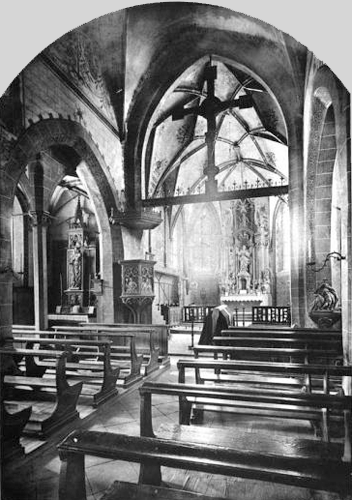
|
| Interior St Peter Herrnshiem, Kunstdenkmäler im Grossherzogthum Hessen: Inventarisirung und beschreibende ... 1877 Google book |
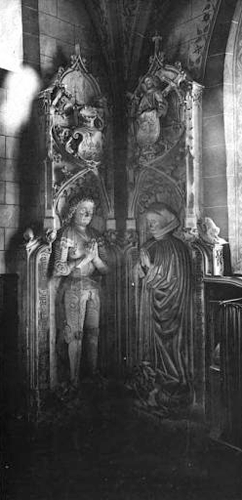
|
|
In the southwest corner of the chapel is the tomb of Philipp Kammerer von Dalberg and
his wife, St Peter Herrnshiem, Kunstdenkmäler im Grossherzogthum Hessen: Inventarisirung und beschreibende ... 1877 Google book
Philipp born in 1418, died in 1492. His wife died in 1483. He is beardless and in full armor. She is draped in a mantel. |

|
|
Tomb of Wolf Kammerer von Dalberg and
his wife, St Peter Herrnshiem, Kunstdenkmäler im Grossherzogthum Hessen: Inventarisirung und beschreibende ... 1877 Google book
Wolf von Dalberg (died 1549) and his wife, Elizabeth nee Fetzer died 1534. The larger than life figures are standing in prayer side by side in two niches. He is bearded and in full armor. She is in a elaborate robe. |
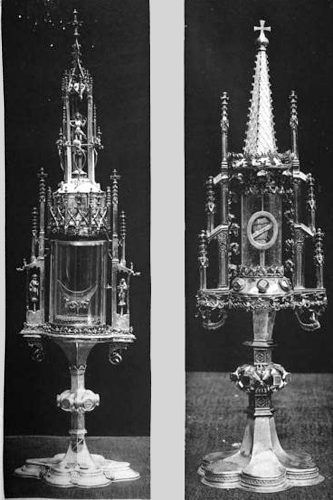
|
|
On the left a late Gothic "Monstranz" of silver and silver gilt with the
Dalberg crest. A monstranz is a a precious liturgical display device.
Decorated with statues of St Petter and Mary Magdalen. On the right a Late Gothic
reliquary.
St Peter Herrnshiem, Kunstdenkmäler im Grossherzogthum Hessen: Inventarisirung und beschreibende ... 1877 Google book
|
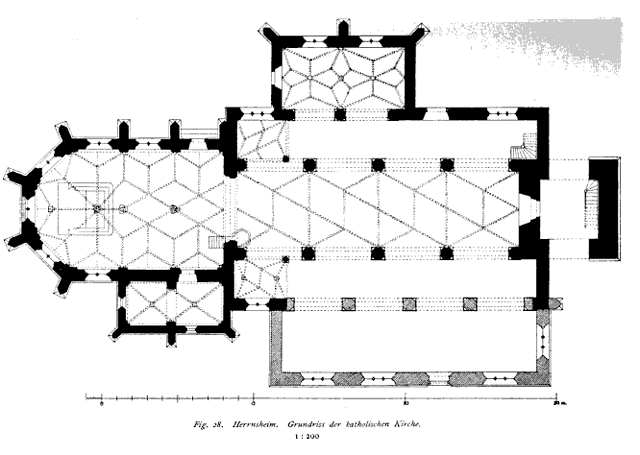
|
| Floor plan of St Peter Herrnshiem, Kunstdenkmäler im Grossherzogthum Hessen: Inventarisirung und beschreibende ... 1877 Google book |
|
| |
|
Other Herrnshiem Sites Worms-Herrnsheim, Rheinland-Pfalz: Names on the 1870-71 Memorial in Herrnsheim
|
|
|
Goehles in Herrnsheim, Germany
Peter Goehle was born in Herrnsheim Germany in 1852. For information on the Goehles in Herrnsheim, Germany go to Goehles in Herrnsheim
| |
|
Arnold in Herrnsheim
Carl Franz Geohle was married to (Anna) Maria Magdelena Arnold, the daughter of Peter Arnold for more information on the Arnolds in Herrnsheim go to Arnold in Herrnsheim
Bardong in Herrnsheim
Johann Bardong born 1725 married Anna Marie Hartbauer For more information on the Bardongs go to Bardong
Cornell in Herrnsheim
Johann Harbauer married Maia Francisca Cornell. They were the parents of Wendelin Harbauer. For more information on the Cornell go to Cornell
Dannfald in Herrnsheim
Heinrich Bardong married Anna Margarethe Dannfald . For more information on the Dannfald family go to Dannfald
Görtz in Herrnsheim
Johann Goehle married Margarethe Gortz, they were the parents of Carol Franz Goehle, the father of Peter Goehle. For more information on the Gortz family in Herrnshiem go to Gortz
Harbauer in Herrnsheim
Franz Geohle was married to Louisa Harbauer for more information on the Harbauers in Herrnsheim go to Harbauer
Heyl in Herrnsheim
Wendelin Harbauer married Franziska Heyl, they were the parents of Lorenz Harbauer who married Margarethe Scheer. For more information on the Hyles go to Heyl
Hoff in Herrnsheim
Johann Peter Goehle married Catherine Hoff. For more information on the Hoffs go to Hoff
Scheer in Herrnsheim
Magdelena Scheer married Lorenz Harbauer, they were the parents of Louisa Harbauer who married Franz Goehle. For more information on the Scheers go to Scheer
Vogt in Herrnsheim Francisco Heyl married Gertrude de Vogt(in) in May 1704. For more information on Vogt in Herrnsheim go to Vogt
Wallreuther in Herrnsheim
Anne Marie Margarethe Wallreuther married Phillip Anton Heyl in 1744. For more information on the Wallreuther family go to Wallreuther
Weinmann in Herrnsheim
Johann Hartbauer married Marie Agnes Weinmann in Herrnsheim in 1717. For more information on Weimann go to Weinmann
|
|
Goehles in Herrnsheim
For information on the Goehle family in Herrnsheim go to Goehles in Herrnsheim
Peter Goehle in New York City
For information on Peter Goehle and his family in New York city go to Peter
Kirkebye
Katherine Goehle married Emil Kirkebye, for more information on the Kirkebyes go to Kirkebye
Goehle Information Connection Page Goehle Homes in New York City Peter Goehle Junior Frank Goehle Immigration New York City Pictures New York City Tenement Life Home |
| If you have any suggestions, corrections, information, copies of documents, or photos that you would like to share with this page, please contact me at maggie@maggieblanck.com |
|
Please feel free to link to this web page. You may use images on this web page provided that you give proper acknowledgement to this web page and include the same acknowledgments that I have made to the provenance of the image. Please be judicious. Please don't use all the images. You may quote up to seventy five words of my original text from this web page and use any cited quotes on this web page provided you give proper acknowledgement to this web page and include the same acknowledgments that I have made to the provenance of the information. Please do not cut and paste the whole page. You may NOT make use any of the images or information on this web page for your personal profit. You may NOT claim any content of this web page as your original idea. Thanks, Maggie |
| © Maggie Land Blanck - page created 2008 - latest update, September 2013 |